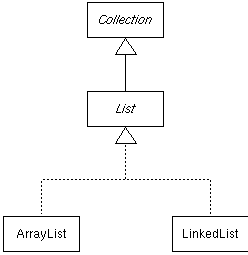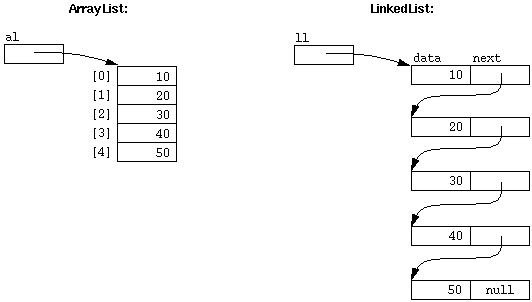-
Chapter 10 (again, for Program 5)
- Chapter 15
-
Covers topics on sample plus exceptions.
-
No file i/o.
-
Possibly Comparable interface.
- No searching or sorting.
-
Lab 13
-- Implement array list
-
Lab 14
-- explore linked list
-
Program 5
-- maze file i/o
- See the writeups for details
-
Figure 1 is a UML diagram of key classes in the Java collection
hierarchy.

Figure 1: Four key components of the Java collection hierarchy.
-
It's a high-level diagram focusing two specific interfaces and two specific
classes
-
It leaves a good deal of detail of intermediate interfaces and abstract classes
not intermediately relevant to the discussion at hand.
- Note how the diagram shows that an interface can extend another interface, as in the List interface extending the Collection interface.
-
It's a high-level diagram focusing two specific interfaces and two specific
classes
-
During class we'll walk through the Java library documentation for this
class/interface hierarchy.
-
We'll start at with the
Collection
interface the top.
-
Then we'll look the
List
interface, which adds methods to impose ordering on a collection.
- We'll then walk through the documentation for two particular classes that implement the List interface -- ArrayList and LinkedList
-
We'll start at with the
Collection
interface the top.
- In upcoming labs and programs you'll be implementing your own simpler versions of Java library lists.
-
A primary purpose of a data structure is to support efficient
computation in a computer program.
-
Efficiency is measured using the "Big-Oh" notation introduced in
Notes 6
-
In Notes 7, we'll discuss further some efficiency trade offs for
different types of data structure, in particular ArrayList and LinkedList.
-
A trade-off means that different data structures are efficient for
certain operations, but inefficient others.
-
However, no single structure may be efficient for all operations.
- Hence, when choosing a data structure to use for a particular program, one must consider carefully the problem to be solved, and choose the data structure the provides the best efficiency available for that problem.
-
However, no single structure may be efficient for all operations.
- The table in Notes 6 illustrates comparative efficiencies for array versus linked structures.
-
Efficiency is measured using the "Big-Oh" notation introduced in
Notes 6
-
A Brief Review of arrays and ArrayLists.
-
You've used Array structures a good deal in CSC 101 and so far in 102.
-
C provides plain arrays, Java provides both arrays and the more flexible
ArrayList class.
- At its core, an ArrayList uses an array to store data.
-
In an ArrayList, elements are stored in a single sequential block.
-
In a LinkedList, elements are in separate
nodes, with links referring to neighboring elements.
-
Figure 2 is a picture of what array and linked structures look like, in
particular for the simple program
ArrayListAndLinkedListExample.java
from
Notes 6.

Figure 2: Array and linked list data structures.
- In class, we'll walk through the library API for java.util.LinkedList
-
The purpose of an iterator in Java is to provide the means to return
all the elements of a collection, without having to know the underlying data
structure within the collection.
-
The examples in Chapter 15 of the book provide a good introduction.
-
Java provides an
Iterator interface
with these key methods:
-
next -- return the next element in a collection
- hasNext -- return true if not at the end of a collection
-
next -- return the next element in a collection
-
There is also a ListIterator interface with these key methods:
-
next -- return the next element in the list
-
hasnext -- return true if not at end of the list
-
previous -- return the previous element in the list
- hasPrevious -- return true if not at the start of the list
-
next -- return the next element in the list
-
All Java Lists implement the listIterator,
meaning they must provide all of its methods.
-
A list iterator starts at beginning of list and returns elements in sequential
order.
-
Iterators can be used conveniently in a for loop, as in the following example
that prints all the persons in a person list:
for (Person p : PersonList) { System.out.println(p); }
-
A list iterator starts at beginning of list and returns elements in sequential
order.
- There are further code examples from the book in 102/examples/book/ch15/impllist/ListIterator.java and 102/examples/book/ch15/impllist/ListTester.java
-
Stacks and queues are used all over the place in programming.
-
Section 15.4 of the book is a good introduction.
-
A stack is a last-in-first-out -- LIFO data
structure.
-
A queue is a first-in-first-out -- FIFO data
structure.
-
The key stack operations are:
-
push -- add to the top
-
pop -- remove from the top
- peek -- get top, no remove
-
push -- add to the top
-
The key queue operations are:
-
enqueue -- add to the end
-
dequeue -- remove from the front
- getFirst -- get first, no remove
-
enqueue -- add to the end
-
Should we use and ArrayList or LinkedList to implement stacks and queues?
-
In class, we'll consider the operations of each and examine the implementation
trade offs.
- You'll be covering these two data structures in much more detail in CSC 103.